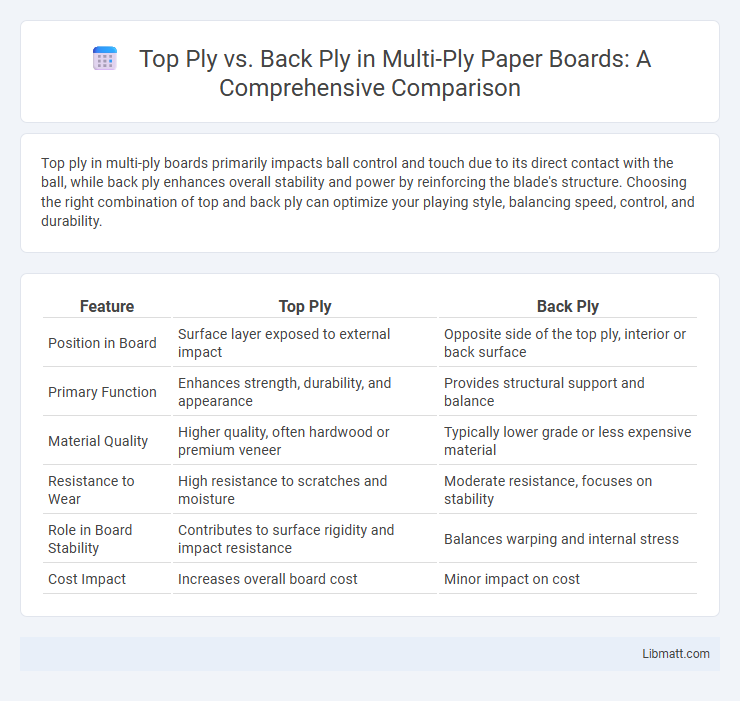Top ply in multi-ply boards primarily impacts ball control and touch due to its direct contact with the ball, while back ply enhances overall stability and power by reinforcing the blade's structure. Choosing the right combination of top and back ply can optimize your playing style, balancing speed, control, and durability.
Table of Comparison
| Feature | Top Ply | Back Ply |
|---|---|---|
| Position in Board | Surface layer exposed to external impact | Opposite side of the top ply, interior or back surface |
| Primary Function | Enhances strength, durability, and appearance | Provides structural support and balance |
| Material Quality | Higher quality, often hardwood or premium veneer | Typically lower grade or less expensive material |
| Resistance to Wear | High resistance to scratches and moisture | Moderate resistance, focuses on stability |
| Role in Board Stability | Contributes to surface rigidity and impact resistance | Balances warping and internal stress |
| Cost Impact | Increases overall board cost | Minor impact on cost |
Introduction to Multi-Ply Boards
Multi-ply boards consist of several layers of wood veneers glued together, with the top ply providing the primary surface exposed to wear and play. The back ply reinforces stability and prevents warping, ensuring structural integrity and consistent performance. Your choice between top ply and back ply materials influences the board's durability, feel, and responsiveness in various sports or applications.
Defining Top Ply and Back Ply
Top ply in multi-ply boards refers to the outermost wood layer that directly influences the board's surface durability, grip, and overall aesthetic appearance. Back ply is the wood layer on the opposite side, contributing primarily to the board's structural integrity, balance, and impact absorption. The combination of top ply and back ply materials determines the performance characteristics and longevity of multi-ply boards in various applications.
Materials Used for Top and Back Plies
Top ply in multi-ply boards typically uses high-quality hardwoods like maple or walnut, chosen for their durability and superior impact resistance, enhancing surface strength and playability. Back plies often incorporate softer woods such as basswood or poplar, which provide flexibility and shock absorption, balancing the board's overall performance. Combining these materials optimizes the board's structural integrity, responsiveness, and longevity in sports equipment like skateboards or table tennis blades.
Importance of Top Ply in Performance
The top ply in multi-ply boards plays a crucial role in performance, directly influencing the board's grip, control, and feel during rides. High-quality materials used in the top ply enhance durability and responsiveness, allowing for precise maneuverability and better friction with the rider's footwear. Compared to the back ply, the top ply's composition is more critical for absorbing impacts and providing a stable platform, making it essential for overall board performance.
Role of Back Ply in Structural Integrity
The back ply in multi-ply boards plays a crucial role in enhancing structural integrity by providing additional strength and support to the overall construction. It helps distribute stress evenly across the board, preventing warping and increasing durability during intense use. Your board's performance and longevity heavily rely on the quality and composition of the back ply material.
Differences in Grain Orientation
Top ply and back ply in multi-ply skateboards differ primarily in grain orientation, where the top ply typically features grains aligned longitudinally to enhance strength and flex under direct pressure. The back ply grains are often oriented transversely or diagonally to improve torsional stiffness and overall board durability. This strategic grain alignment in multi-ply construction balances the skateboard's responsiveness and resilience during tricks and impacts.
Impact on Board Durability
Top ply and back ply in multi-ply boards significantly influence board durability, with the top ply primarily responsible for resisting surface wear and abrasion, while the back ply provides structural support and prevents warping over time. High-quality top ply made from durable wood or composite materials enhances impact resistance and protects against scratches, extending your board's lifespan. Selecting multi-ply boards with balanced, robust top and back plies ensures lasting performance and maintains optimal board integrity under heavy use.
Moisture Resistance: Top vs. Back Ply
Top ply in multi-ply boards offers superior moisture resistance due to its dense, high-quality veneer and protective finish, effectively shielding your surface from water damage. Back ply layers, often composed of lower-grade plywood, provide structural stability but are more susceptible to moisture absorption and warping over time. Prioritizing a robust top ply ensures enhanced durability and longevity in environments prone to humidity or spills.
Selection Criteria for Quality Multi-Ply Boards
Top ply and back ply in multi-ply boards significantly influence durability, flexibility, and performance, making them essential selection criteria for quality. You should prioritize top ply made from high-quality hardwoods like maple or birch for superior surface strength and strike response, while back ply often uses softer woods to enhance board flexibility and reduce weight. Examining ply thickness, adhesive type, and overall ply construction ensures a balance between resilience and agility, optimizing your multi-ply board's longevity and playability.
Conclusion: Choosing the Right Ply Combination
Top ply and back ply in multi-ply boards significantly affect durability, flexibility, and performance, with top ply often made from high-quality hardwoods for enhanced impact resistance and back ply designed for structural support and flexibility. Selecting the right ply combination depends on the intended use, where aggressive play styles benefit from a stiffer top ply, and players seeking control and smoothness prefer a balanced or softer back ply. Understanding the material properties and layering techniques ensures optimal board performance tailored to specific sports or applications.
Top ply vs back ply (multi-ply boards) Infographic

 libmatt.com
libmatt.com